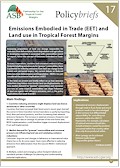| Brief |
 |
|
| Title | Emissions Embodied in Trade (EET) and Land use in Tropical Forest Margins | | Author | Peter Akong Minang, Meine van Noordwijk, P Meyfroidt, Fahmuddin Agus and Sonya Dewi | | Year | 2010 | | Publisher | ASB Partnership for the Tropical Forest Margins | | City of Publication | Nairobi, Kenya | | Series Number | ASB Policy Brief no 17 | | Number of Pages | 4 | | Call Number | PB0014-10 |
|
| Abstract: |
Increasing proportions of land use change responsible for emissions from deforestation, forest degradation and agriculture in developing countries is associated with commodities meant for export, hence the concept of Emissions Embodied in Trade-
EET.
As many corporations, countries and consumers embrace carbon footprint labelling and advocate for “greener” commodities, there is potential for reducing emissions from land use change in the humid and sub-humid tropics. Yet, current debate on Reduced Emissions from Deforestation and Degradation – REDD+ has not considered the potential implications of EET.
In this brief, we present and briefly reflect on (a) how emission reductions may induce cross-border land use displacements; (b) how market demand for “greener” commodities and consumer pressure on some tropical commodities can shape behaviour of land use agents and influence emissions; and (c) the policy implications that result from EET. |
|
|
Download file(s): Click icon to download/open file.
|
| |
File Size |
Description |

|
1,779 KB |
Softcopy |
|
|
|
| Viewed in 2652 times. Downloaded in 607 times. |